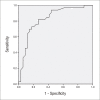New Cardiovascular Biomarkers in Breast Cancer Patients Undergoing Doxorubicin-Based Chemotherapy
- PMID: 38232245
- PMCID: PMC10789374
- DOI: 10.36660/abc.20230167
New Cardiovascular Biomarkers in Breast Cancer Patients Undergoing Doxorubicin-Based Chemotherapy
Abstract
Background: Central Illustration : New Cardiovascular Biomarkers in Breast Cancer Patients Undergoing Doxorubicin-Based Chemotherapy. Cardiovascular diseases (CVDs) are relevant to the management of breast cancer treatment since a substantial number of patients develop these complications after chemotherapy.
Objective: This study aims to evaluate new cardiovascular biomarkers, namely CXCL-16 (C-X-C motif ligand 16), FABP3 (fatty acid binding protein 3), FABP4 (fatty acid binding protein 4), LIGHT (tumor necrosis factor superfamily member 14/TNFS14), GDF-15 (Growth/differentiation factor 15), sCD4 (soluble form of CD14), and ucMGP (uncarboxylated Matrix Gla-Protein) in breast cancer patients treated with doxorubicin (DOXO).
Methods: This case-control study was conducted in an oncology clinic that included 34 women diagnosed with breast cancer and chemotherapy with DOXO and 34 control women without cancer and CVD. The markers were determined immediately after the last cycle of chemotherapy. The statistical significance level adopted was 5%.
Results: The breast cancer group presented higher levels of GDF-15 (p<0.001), while control subjects had higher levels of FABP3 (p=0.038), FABP4 (p=0003), sCD14, and ucMGP (p<0.001 for both). Positive correlations were observed between FABPs and BMI in the cancer group.
Conclusion: GDF15 is an emerging biomarker with potential clinical applicability in this scenario. FABPs are proteins related to adiposity, which are potentially involved in breast cancer biology. sCD14 and ucMGP engage in inflammatory and vascular calcification. The evaluation of these novel cardiovascular biomarkers could be useful in the management of breast cancer chemotherapy with DOXO.
Fundamento: Figura Central: Novos Biomarcadores Cardiovasculares em Pacientes com Câncer de Mama Submetidas a Quimioterapia à Base de Doxorrubicina. As doenças cardiovasculares (DCV) são relevantes para o manejo do tratamento do câncer de mama, uma vez que um número significativo de pacientes desenvolve essas complicações após a quimioterapia.
Objetivo: Este estudo teve como objetivo avaliar novos biomarcadores cardiovasculares, sendo eles CXCL-16 (ligante de motivo C-X-C 16), FABP3 (proteína de ligação a ácidos graxos 3), FABP4 (proteína de ligação a ácidos graxos 4), LIGHT (membro da superfamília do fator de necrose tumoral 14/TNFS14), GDF-15 (fator de crescimento/diferenciação 15) , sCD4 (forma solúvel de CD14) e ucMGP (matriz Gla-proteína não carboxilada) em pacientes com câncer de mama tratadas com doxorrubicina (DOXO).
Métodos: Este estudo de caso-controle foi realizado em uma clínica oncológica, incluindo 34 mulheres com diagnóstico de câncer de mama tratadas com quimioterapia com DOXO e 34 mulheres controle, sem câncer ou DCV. Os marcadores foram determinados imediatamente após o último ciclo de quimioterapia. O nível de significância estatística adotado foi de 5%.
Resultados: O grupo com câncer de mama apresentou níveis mais elevados de GDF-15 (p<0,001), enquanto os indivíduos controle apresentaram níveis mais elevados de FABP3 (p=0,038), FABP4 (p=0003), sCD14 e ucMGP (p<0,001 para ambos). Correlações positivas foram observadas entre FABPs e IMC no grupo com câncer.
Conclusão: GDF15 é um biomarcador emergente com potencial aplicabilidade clínica neste cenário. FABPs são proteínas relacionadas à adiposidade, potencialmente envolvidas na biologia do câncer de mama. sCD14 e ucMGP estão envolvidos na calcificação inflamatória e vascular. Acima de tudo, a avaliação destes novos biomarcadores cardiovasculares pode ser útil no tratamento da quimioterapia do câncer de mama com DOXO.
Conflict of interest statement
Potencial conflito de interesse
Não há conflito com o presente artigo
Figures






Similar articles
-
The coincidence of low vitamin K status and high expression of growth differentiation factor 15 may indicate increased mortality risk in stable coronary heart disease patients.Nutr Metab Cardiovasc Dis. 2021 Feb 8;31(2):540-551. doi: 10.1016/j.numecd.2020.09.015. Epub 2020 Sep 22. Nutr Metab Cardiovasc Dis. 2021. PMID: 33257192
-
Desphospho-Uncarboxylated Matrix-Gla Protein Is Increased Postoperatively in Cardiovascular Risk Patients.Nutrients. 2018 Jan 5;10(1):46. doi: 10.3390/nu10010046. Nutrients. 2018. PMID: 29303985 Free PMC article.
-
Uncarboxylated matrix Gla-protein: A biomarker of vitamin K status and cardiovascular risk.Clin Biochem. 2020 Sep;83:49-56. doi: 10.1016/j.clinbiochem.2020.05.005. Epub 2020 May 15. Clin Biochem. 2020. PMID: 32422228
-
Circulating uncarboxylated matrix Gla protein, a marker of vitamin K status, as a risk factor of cardiovascular disease.Maturitas. 2014 Feb;77(2):137-41. doi: 10.1016/j.maturitas.2013.10.008. Epub 2013 Oct 24. Maturitas. 2014. PMID: 24210635
-
Matrix Gla-protein: the calcification inhibitor in need of vitamin K.Thromb Haemost. 2008 Oct;100(4):593-603. Thromb Haemost. 2008. PMID: 18841280 Review.
Cited by
-
Biomarkers in the Evaluation of Patients Undergoing Chemotherapy with Anthracyclines.Arq Bras Cardiol. 2024 Mar 4;120(12):e20230821. doi: 10.36660/abc.20230821. eCollection 2024. Arq Bras Cardiol. 2024. PMID: 38451618 Free PMC article. English, Portuguese. No abstract available.
References
-
- Early Breast Cancer Trialists’ Collaborative Group (EBCTCG) Peto R, Davies C, Godwin J, Gray R, Pan HC, et al. Comparisons between Different Polychemotherapy Regimens for Early Breast Cancer: Meta-Analyses of Long-Term Outcome Among 100,000 Women in 123 Randomised Trials. Lancet. 2012;379(9814):432–444. doi: 10.1016/S0140-6736(11)61625-5. - DOI - PMC - PubMed
MeSH terms
Substances
LinkOut - more resources
Full Text Sources
Medical
Research Materials
Miscellaneous

